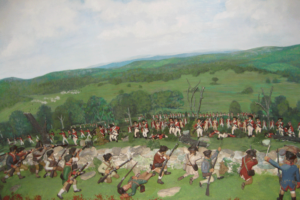Andebit et beaqui corendit, ut quostes esciendion re dit ad et prae parion es quia quas alibus sam, omnim faciden ducipidiat arum autem nobis enis es voat

14. Putnam Pocket Park: The Battle of Hubbardton
British and Rebels engage in the first revolutionary battle in Vermont.
Listen to the Turning Point Trail Site 14 Audio Narration:

Diorama of the Battle of Hubbardton. Courtesy of Vermont. Division for Historic PreservationAmerican forces fleeing from Fort Ticonderoga and Mount Independence coalesced into several distinct groups as they made their way toward Castleton, Vermont, where they hoped to regroup. Stopping temporarily at Hubbardton to rest, General St. Clair instructed Seth Warner of the Green Mountain Boys to command a rearguard of a combined force of his Green Mountain Boys, Nathan Hale’s 2nd New Hampshire (which had been gathering stragglers), and Ebenezer Francis’s 11th Massachusetts (which, having been designated to provide the cover for the initial withdrawal, had yet to appear). The vanguard under St. Clair continued on its way to Castleton, where they settled in for the night. Throughout much of the day, British General Simon Fraser’s Advance Corps remained in close pursuit, with General Friedrich Riedesel’s Brunswickers close behind. By nightfall, exhausted forces from both sides were strung out along the Ticonderoga-Castleton road and settled in for some much-needed rest—St. Clair in Castleton; Warner, Hale, and Francis in Hubbardton; Fraser three miles further back; and Reidesel trailing Fraser by another few miles. Fraser had his men up and moving by 3 a.m. on the 7th of July. Electing not to wait for Riedesel’s reinforcements, Fraser sent two companies from his own 24th Regiment under Major Robert Grant into action, attacking Colonel Nathan Hale’s troops along the brook. Rebel troops fired from behind an abbatis (obstacle formed with tree branches laid in a row, with the sharpened tops directed outwards, towards the enemy), inflicting 22 British casualties including Major Grant himself. Fraser then initiated a flanking action, and, for the next several hours, fierce back-and-forth fighting ensued, both sides trying to gain an advantage from occupying neighboring hilltops. Rebel forces spent much of the battle repelling several British attempts to overrun their primary defensive position established on what is now known as Monument Hill. At one point, two companies of British grenadiers encountered 60 Americans presenting “clubbed” muskets—firearms held in the air butt high, a symbol of surrender. At 30 feet, the Americans reversed their weapons and fired, inflicting heavy casualties before turning tail and fleeing through the woods, pursued by the remaining incensed grenadiers. Attack and counter-attack continued until the arrival of Riedesel, whose fresh Brunswickers shifted the balance. With the Castleton Road cut off as an avenue of escape, Warner ordered his men to pull back to the east. While crossing an open wheat field, the gallant Colonel Ebenezer Francis, wounded but still calling out orders to his men, was cut down by enemy fire. The sight of him falling sent the Americans into flight across the Pittsford Ridge toward Rutland and New Hampshire. The fighting at Hubbardton was over. The stiff resistance put up by the Rebel troops made Hubbardton a costly victory for the British. The American rearguard action had served its purpose, putting more distance between the British pursuit and the main body of American troops, inflicting heavy casualties on well trained British units, and demonstrating the rebellious Colonials’ willingness to fight. Hubbardton was the only battle of the Revolutionary war fought in what is now Vermont. At the time it was territory disputed by New York, New Hampshire, and independent-minded settlers in the contested area, who had declared their independence in January 1777 but had yet to be recognized by Congress.
Travel Tools
This begins day two of your Turning Point Trail Trip. If you didn’t get a chance to tour Fort Ticonderoga the day before, take a tour in the morning before heading south on Route 22.
Just south of Wrights Ferry Road, you’ll see a pull-off on your right-hand side. From here, at Putnam Pocket Park, looking southeast (across the road), you’ll get a good view of Hubbardton. After taking in the view, start track 14 and continue driving south toward the drowned lands. As you drive, you’ll continue to catch glimpses of Vermont on the left, where all the action you’re hearing about took place.
CLICK TO ADVANCE PAGE TO SITE FIFTEEN
Learn More
First-Hand Accounts
While Fraser pursued the Rebels in Vermont, Burgoyne sailed south for Whitehall:
“Brigadier Frazer was advancing, leaving orders for the brigade to follow with intentions to pursue by land. Knowing the safety I could trust to that Officer’s conduct, I turned my chief attention to the pursuit by Water, by which route I had intelligence one column were retiring in two hundred and twenty bateaux covered by fire armed gallies. …Major Gen. Riedesel was directed to proceed by Land to sustain Brigadier Frazer or to act more to the Left if he saw it expedient to do so.” –General John Burgoyne
General Riedesel arrived just in time to help Brigadier Fraser in his battle with the Rebels in Hubbardton:
“The Brigadier in momentary expectation of the arrival of the Germans had latterly weakened his left flank to support his right flank. At this critical moment Major Gen. Riedesel arrived with the foremost of his column… His judgment instantly pointed to him the course to take. He extended upon Brigadier Frazer’s left flank. The enemy fled on all sides leaving dead upon the field … Major General Riedesel and those he commanded pressed for a share of the glory and they arrived in time to obtain it.” –General John Burgoyne


